Finally Cambridgeshire County Council has brought forward some proposals for Tenison Road after much delay. About £500,000 of developer contributions (Section 106) money is to be spent in addition to about £150,000 to replace the traffic signals and £150,000 from the resurfacing budget, making a grand total of £800,000 for about 500m of local road, quite a sum.
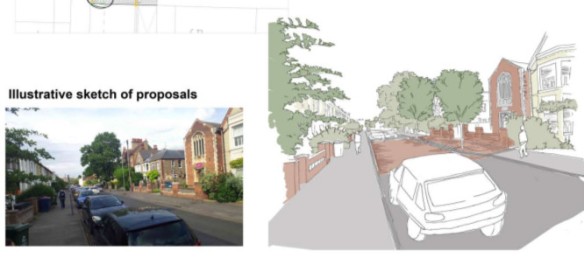
A portion of the proposal for Tenison Road: the impact of parked cars and moving traffic has been de-emphasised.
The developer contributions are intended to “help ease traffic impact resulting from the CB1 development” and the proposals are called “traffic improvements”. Herein lies the rub: the proposals are about motor traffic and are not about improving the area. If you want to improve the area then concentrate on that and not on the traffic (see below for the failure of the hierarchy of modes).
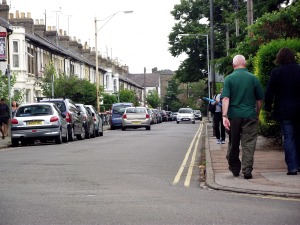
The north section of Tenison Road is straight with a sharp bend. Parked cars dominate the streetscape.
The dominant factor shaping Tenison Road is the traffic along it between Mill Road and the railway station. There are about 4,500 vehicles a day on Tenison Road with >80% of these being cars or vans and typically no more than two (number) multi-axle lorries. [Data from Cambridge City Council’s 20mph project base data.] As the blog post on Placefaking makes so clear, if the street is a rat-run then you can’t transform the streetscape without reducing the traffic, you can’t make the street feel like a ‘place’ by adding trees and pretty paving that is simply putting lipstick on a pig. [Hat tip to Hester for the reference.]
There is nothing in the County’s proposals that will reduce or discourage motor traffic on this route, the best they are hoping for is to reduce some of the excesses and encourage compliance with the 20mph speed limit through expensive infrastructure. They hope that a variation in the surface, through coloured block paving, will make drivers a bit uncertain and slow down. By adding parking and some trees (obstructions in the highway) they hope to break up the straight lines and slow drivers. It’s a bit like shared space but it’s not shared space.
While this approach may work where drivers are unfamiliar with the road a large number of the vehicles on this road are taxis, who know the road very well. Many drivers happily speed down nearby Devonshire Road towards the blind corner and overtake cycles despite being unable to see round the corner.
Despite there being around £150,000 to spend on resurfacing this will only be spent on the area between the footways. Despite the claim that this traffic improvement scheme will “maintain safety and comfort for pedestrians” the footways will not be resurfaced despite being in a poor state in some places. The resurfacing budget is only for the benefit of motor vehicles. The County is so disinterested in people walking that they have not even bothered to count them before drawing up these proposals.
The failure of the ‘hierarchy of modes’
Cambridgeshire claims, in the Cambridgeshire Local Transport Plan 2011 – 2026, Policies and Strategy, that a hierarchy “will be used as a guide for setting priorities and allocating funding towards programme areas and schemes”, and the hierarchy is (most important first):
- Pedestrians
- Cyclists
- Public transport
- Specialist service vehicles (e.g. emergency services, waste collection, disabled drivers)
- Other motor vehicles
But this hasn’t happened on Tenison Road. The County’s representative claimed that people had been put first because an architect had designed the block paving to match the colour of adjacent buildings.
Here’s the effective hierarchy on Tenison Road:
- Residents’ parking, which is to be maintained and increased.
- Taxis and residents’ private motor vehicles; both groups would object vociferously if Tenison Road were no longer a through road.
- Private motor vehicles cutting through this residential area; the imperative to not interrupt the traffic flow.
- People on cycles, who had their provision between Devonshire Road and St Barnabas Road removed in some drafts.
- People on foot, who get a zebra crossing on a corner and some unspecified changes at the traffic signals.
My view on what should be done
Since there is no appetite to actually reduce motor traffic on Tenison Road in a way that would make a difference to the people living on the road, we should not waste £500,000 on ineffective streetscape changes. Let’s not spend £500,000 on lipstick. The money probably can’t be spent on something ‘useful’ but that’s no reason to waste it here.
There seems to be a view that money from developers is somehow ‘free’ money, in reality of course it is paid for by the businesses and individuals who buy or let the buildings in the CB1 development. Think of it this way: “The price of your flat is £370,000 plus £5,000 towards block paving, trees and car parking for other people on Tenison Road. No, you can’t have a parking space.”
I also have some ideas on cheap and effective changes that would slow and discourage motor traffic on Tenison Road.
Traffic signal priority
When the traffic signals are renewed at the Devonshire Road and St Barnabas Road junctions the priority should be set so the side roads are normally green, or the pedestrian phase is normally green, and vehicles on Tenison Road normally have to stop at a red and wait. This will give priority to people crossing and to people cycling between the station and the city centre. It will slow down vehicles on Tenison Road and it will make this route less attractive as a fast through route.
The cost of this is within the signal replacement budget.
Narrow gates
A ‘gate’ could be added at the corner on Tenison Road with a very narrow gap. We know from the gates between Romsey Town and Cromwell Road that these slow traffic and discourage through trips.
The gates in Romsey Town are a bit ugly, so how about a narrowing the road by lowering it by about 0.5m between tight kerbs? A lowered channel would be largely invisible in the street.
A sense of place
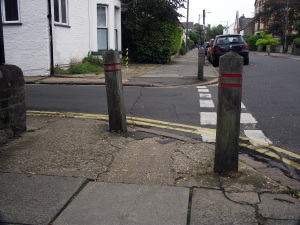
The junction with Felton Street has a series of hazards for people walking and this junction isn’t needed.
Two of the side roads off Tenison Road, Wilkin and Felton Streets, could be closed entirely to motor vehicles, or closed at the Tenison Road end (one has parking the other does not). With the junctions on to Tenison Road closed these streets could be given a sense of place with, for example, a pocket park, play equipment, cycle parking and a larger outside area for the Salisbury Arms pub. In addition the footway on Tenison Road will be improved by removing two roads that cut across it.
So should we be spending £800,000 on a few trees and some pretty paving (aka lipstick) that will have minimal impact on traffic on Tenison Road? If there’s no appetite for a meaningful change to this road let’s be more cautious with our money.

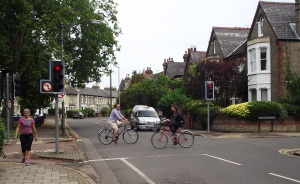
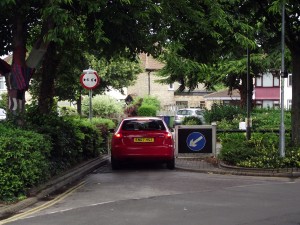
Brilliant summary of the proposals. Do some some of our posts on the consultation here
Can we assume that the Wilkin and Felton Rd closures will maintain cycle access?
I would expect there to be cycle access. Just for the avoidance of doubt, closing those roads to motor traffic is an idea of mine and not something that is being consulted on.
Very constructive comments and criticism.The use of Tenison Road as a through route by taxis also causes difficulties and hazards on Mill Road – at the Tenison Road junction and all along Mill Road as far as the fire station. The traffic along this route is likely to increase (I don’t need a survey to know this!). An increasing amount of traffic is also turning right from Mill Road into Devonshire Road – ignoring the unclear prohibition. Devonshire Road is (effectively) a one-way street. The Council needs to develop some through routes from the station, which will need substantial demolition and a considerable investment. So be it – the councils have effectively done nothing for traffic since the 1920s – except throttle it – and has increased somewhat since then – it is likely to increase further (again I don’t need a survey to work that one out).
Thanks for your comments Stephen. Traffic will increase if left unconstrained, however Department for Transport statistics show that the number of motor vehicle journeys have remained static (nationally) for the past decade. The new Science Park station should take some pressure off the current station, as would an Addenbrookes station that now appears to be being talked about again. Similarly the Chisholm Trail and an eastern entrance to the station could also reduce motor traffic in the area.
There is consideration of closing Hills Road north of Station Road to through traffic, and many would like Mill Road to be a no through route. What happens when you close routes is that the traffic evaporates: people find other ways to move about or other routes, so this is entirely possible with political will. The closing of Romsey town and Petersfield to through traffic some 30 years ago vastly improved those residential streets though I am sure there were concerns about traffic chaos at the time.
While the post-war plans envisioned a four to six lane overhead ring road for Cambridge (see other post on this site) I am pleased that the days of such ruinous plans seem to have passed.
interesting to read that you rank pedestrians in last place in the hierarchy; installing a crossing on the bend in Tension Road. To allegedly ‘improve sight lines’ for pedestrians to cross on the bend, the Council narrowed the road, by widening the pavement. As a result, cars (mainly taxis) now mount the pavement endangering the lives of pedestrians. A single wooden post has been installed on the bend as a ‘safety feature’. Just why a whole line of posts was not installed, as the Council did at Mill Rd end, God only knows!
I was taught the green cross code as a child. The 1st point was to find a safe place to cross. Certainly not on a bend in the road where cars mount the curb!!
How much of the £800k budget went on this ‘improvement’???
Generally I’m not in favour of bollards to keep cars off the footway because they narrow the footway and create a hazard for the visually impaired. They are basically an admission that something else has gone wrong. Sometimes raising the carriageway to create ‘raised tables’ means there’s no longer a kerb which makes it much easier for vehicles to drive over the footway, so you have to ask who has benefited from the raised carriageway most? Perhaps it’s just help vehicles claim another part of the road.